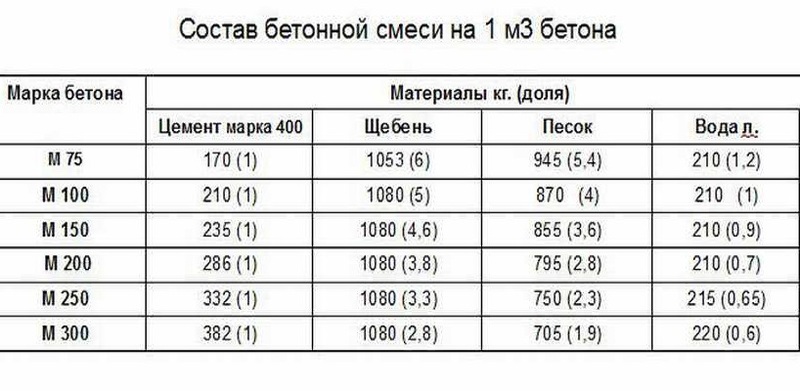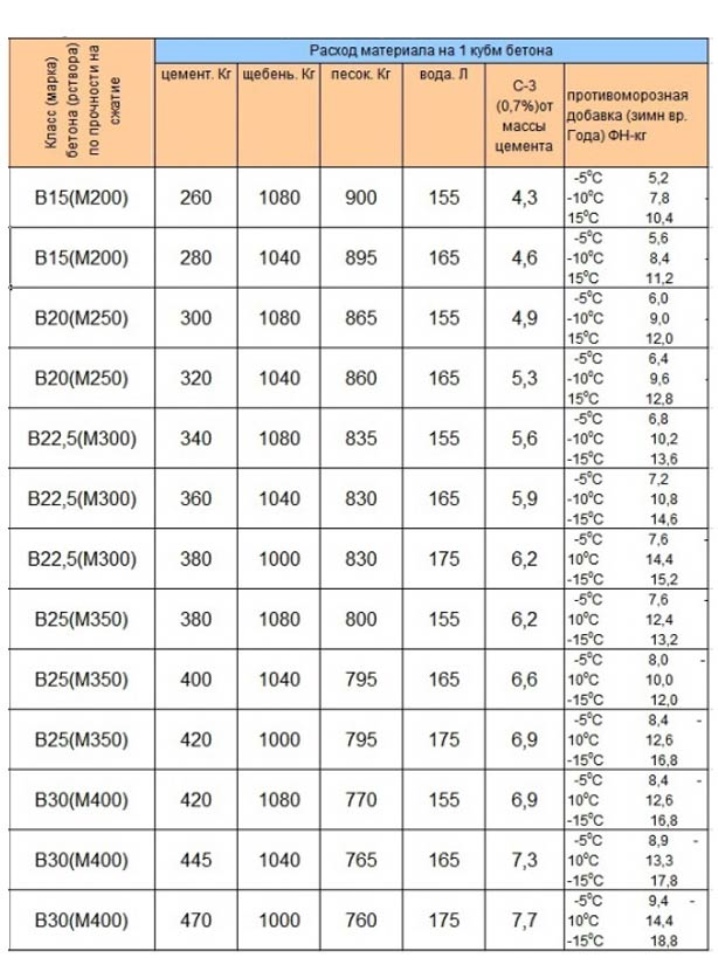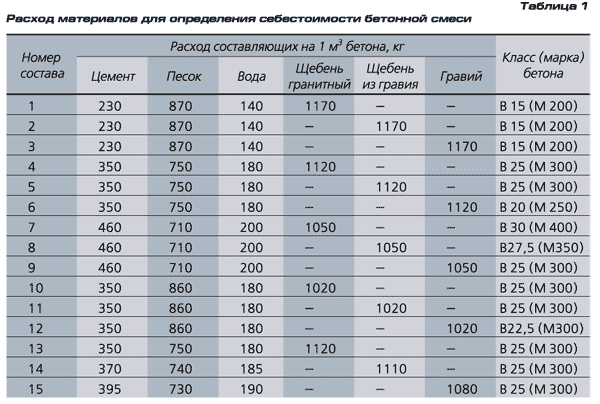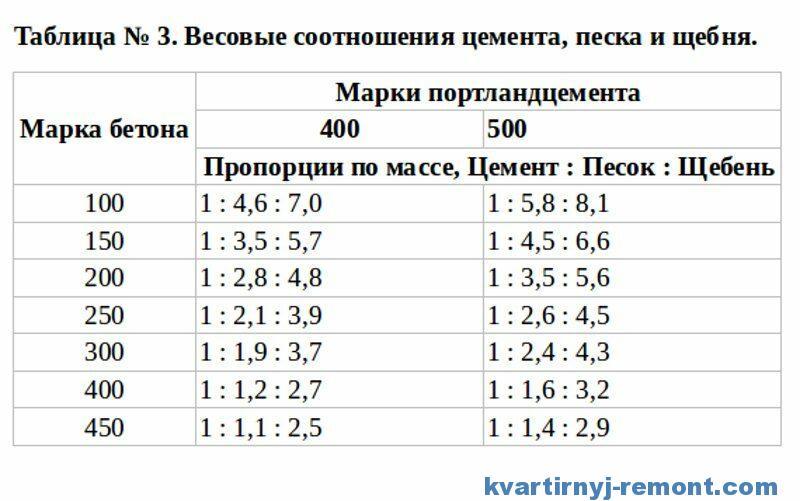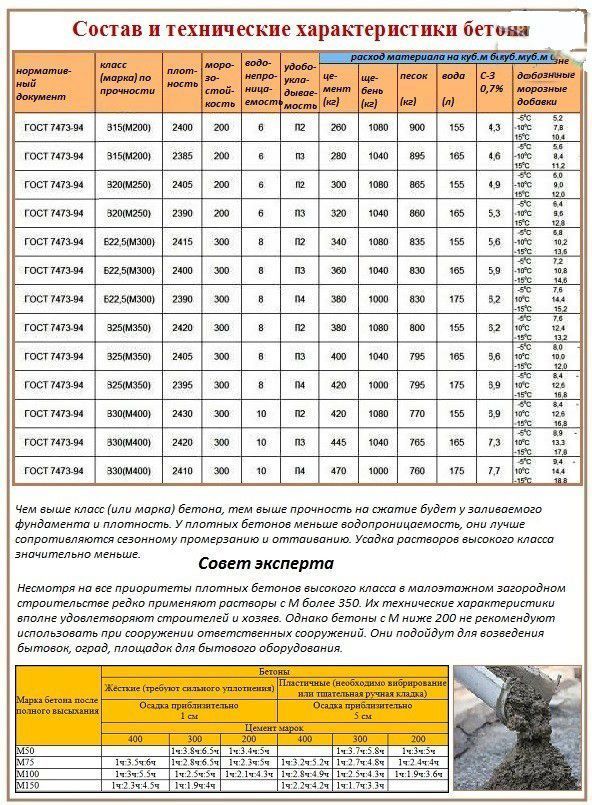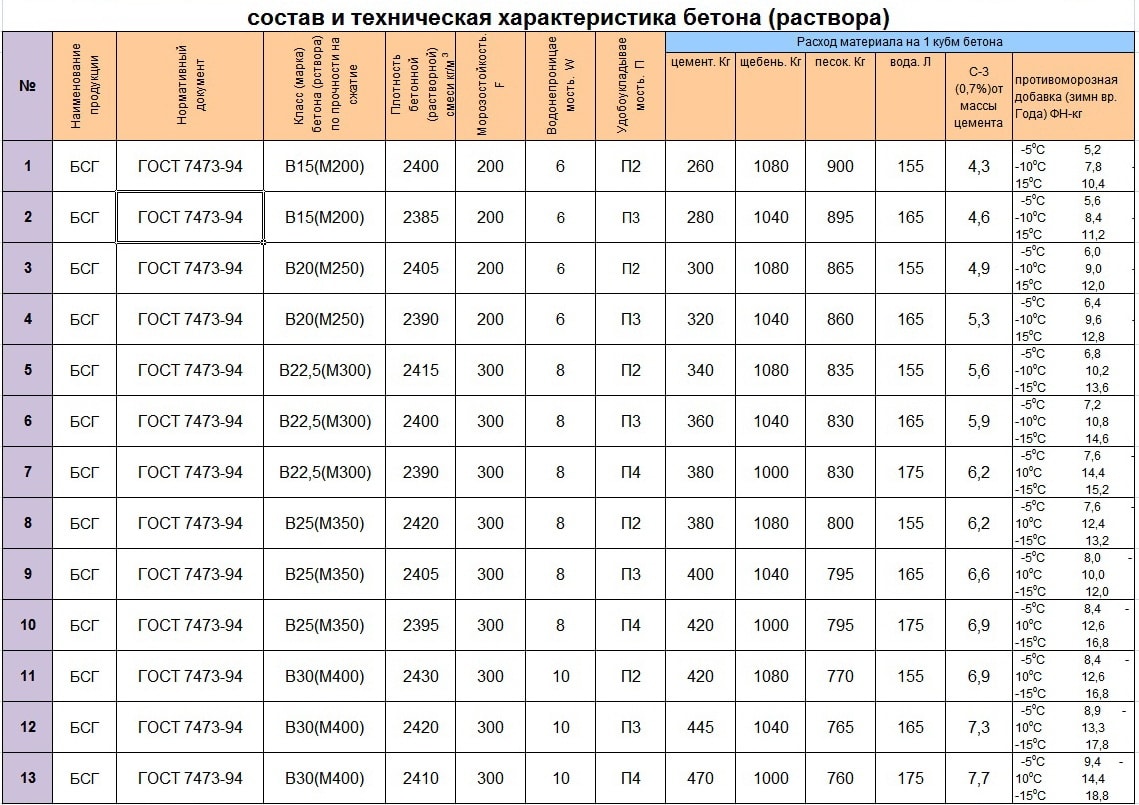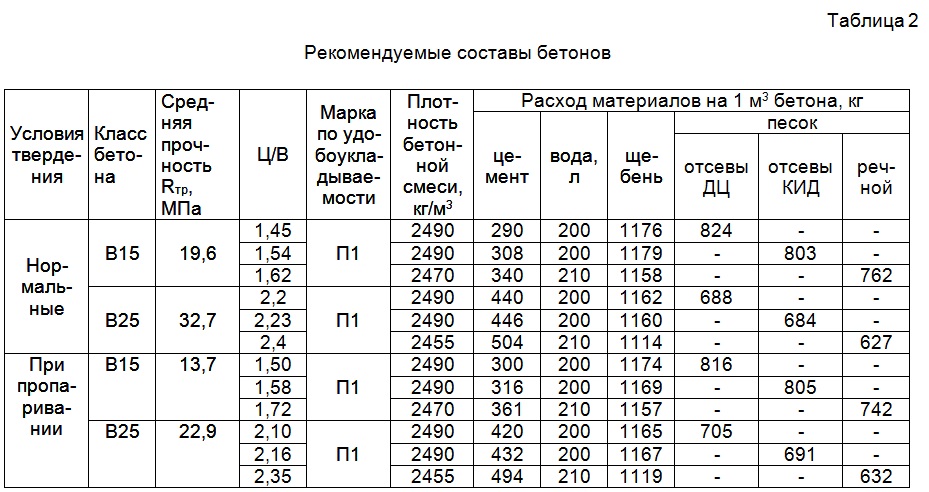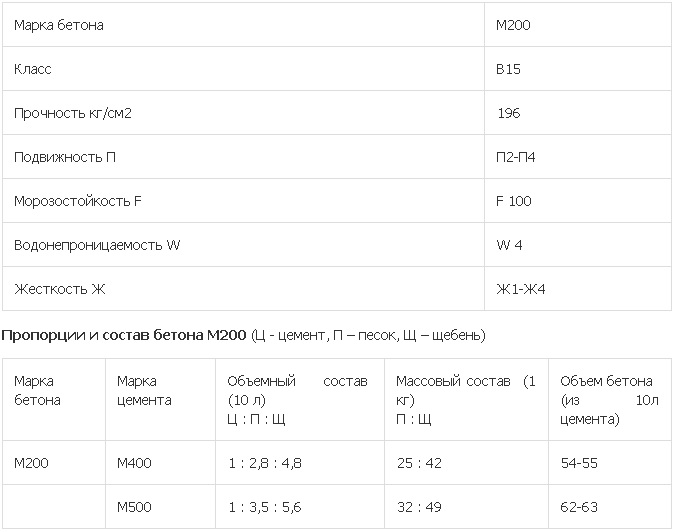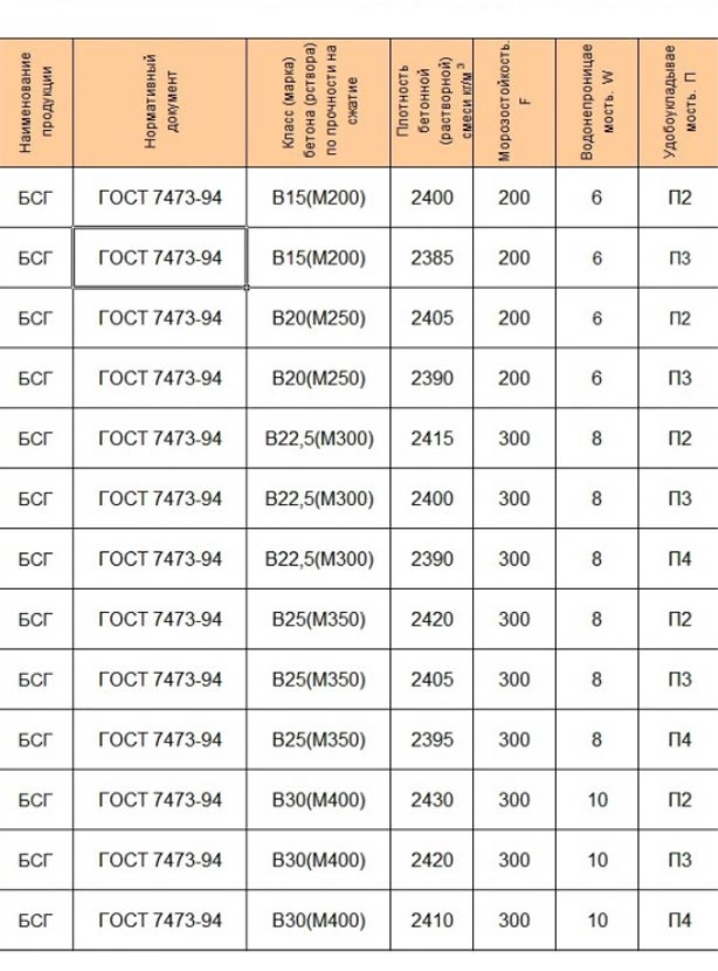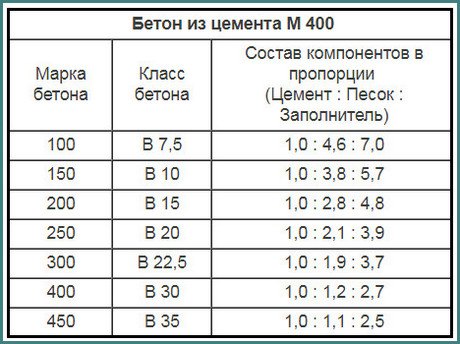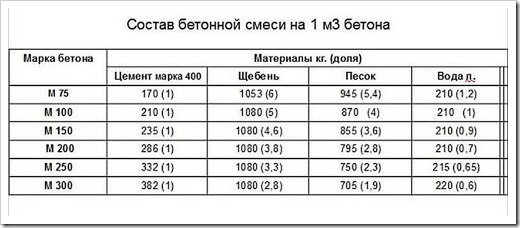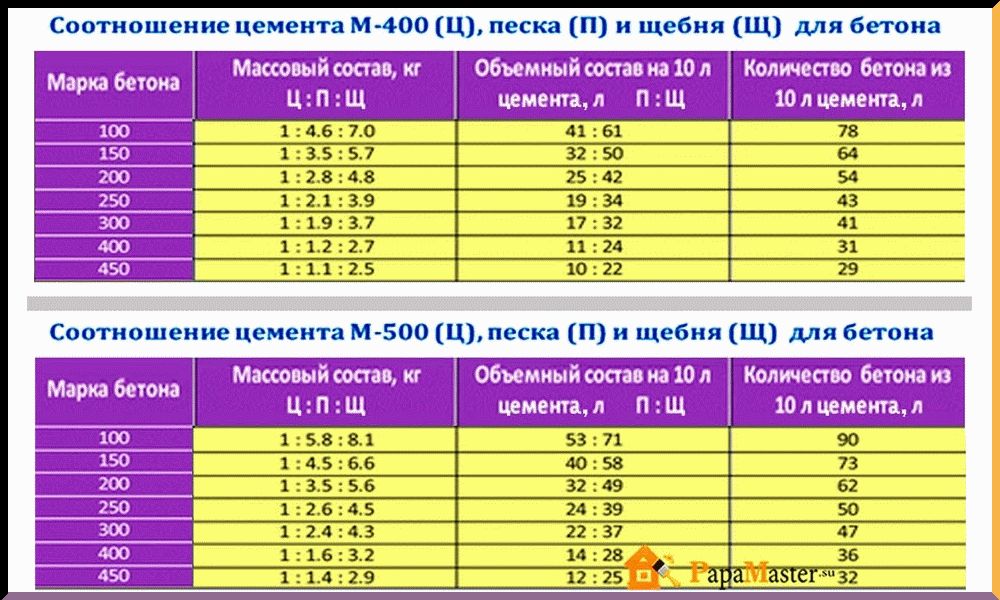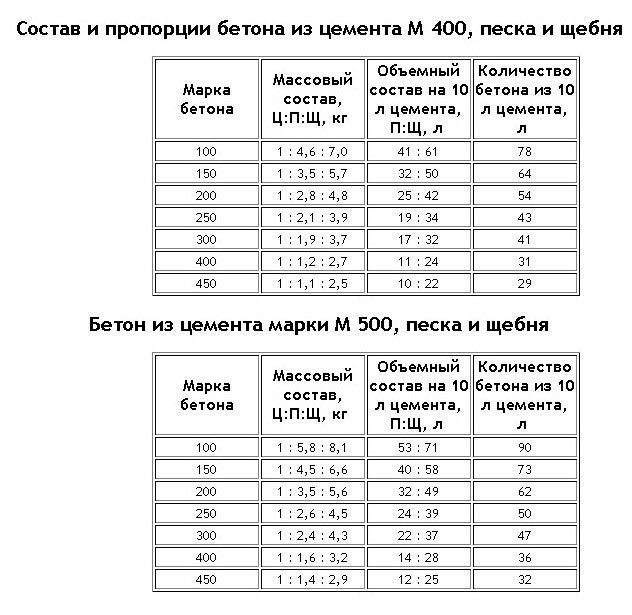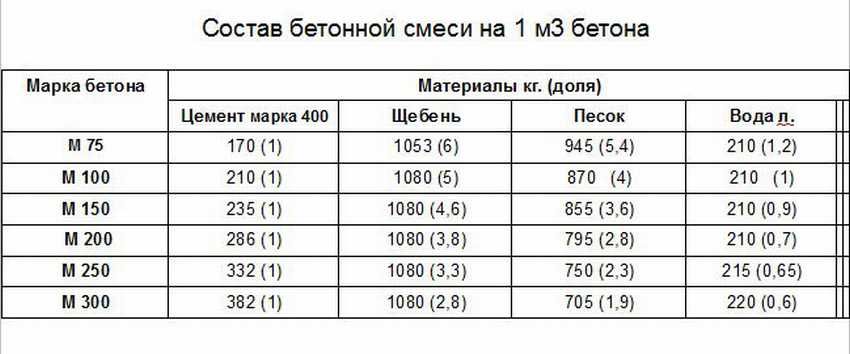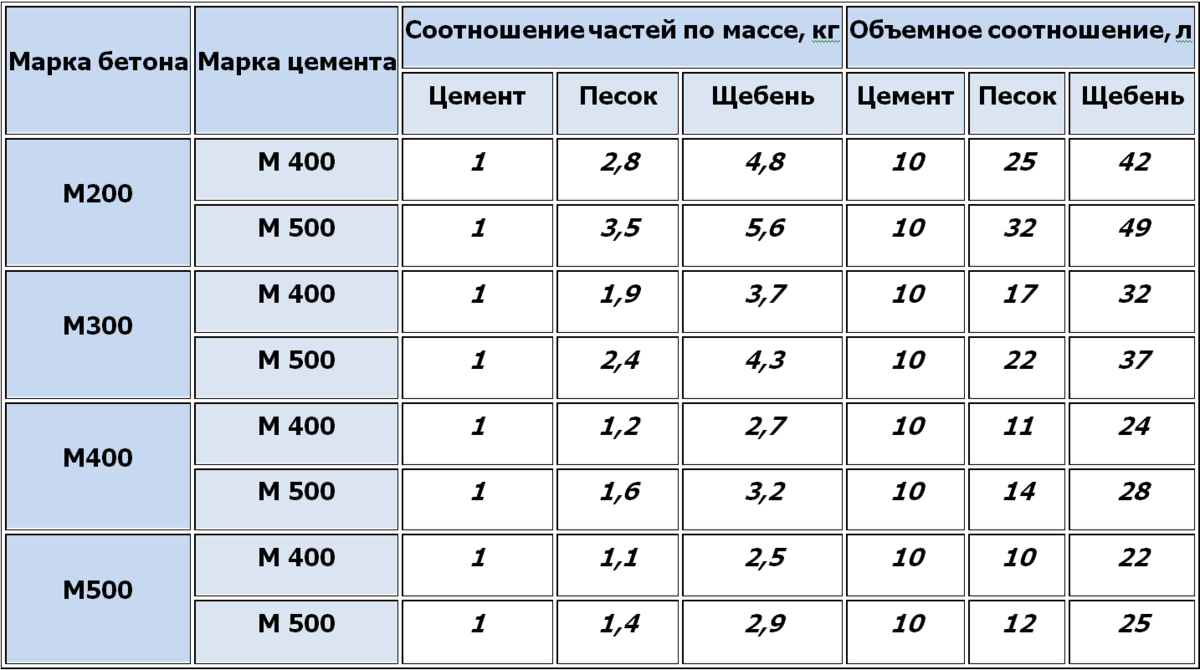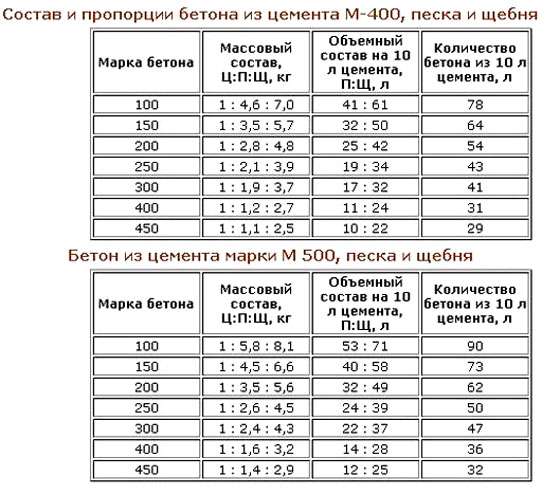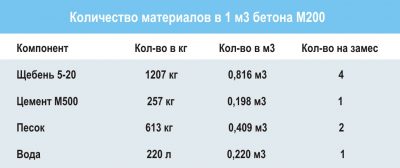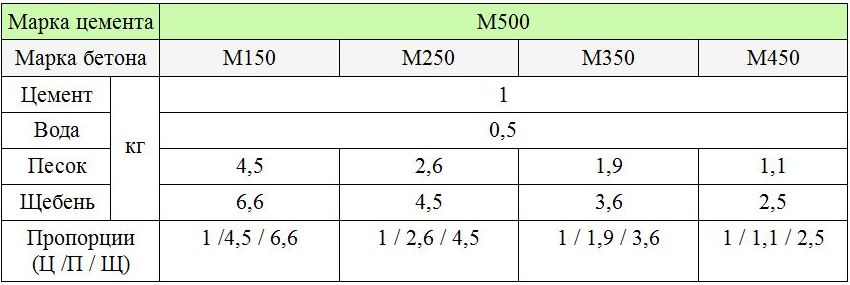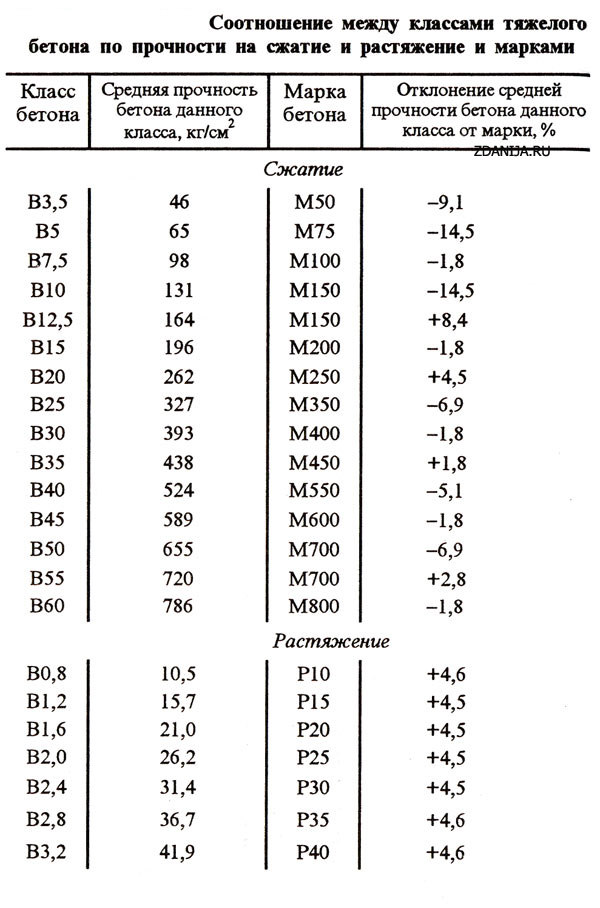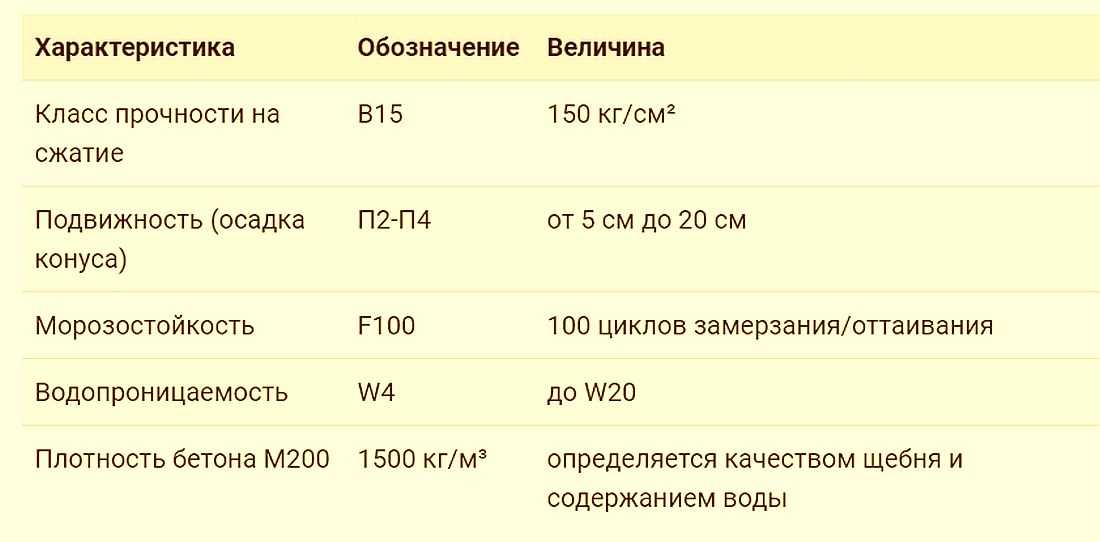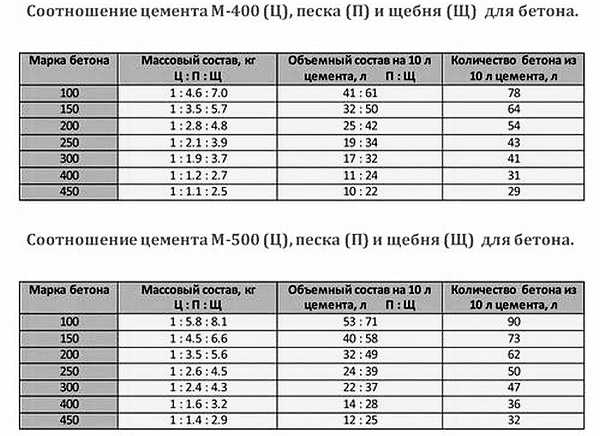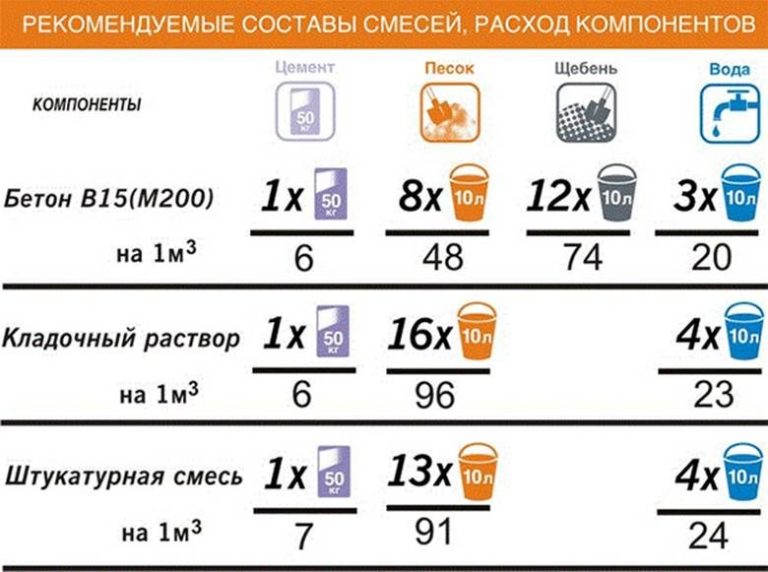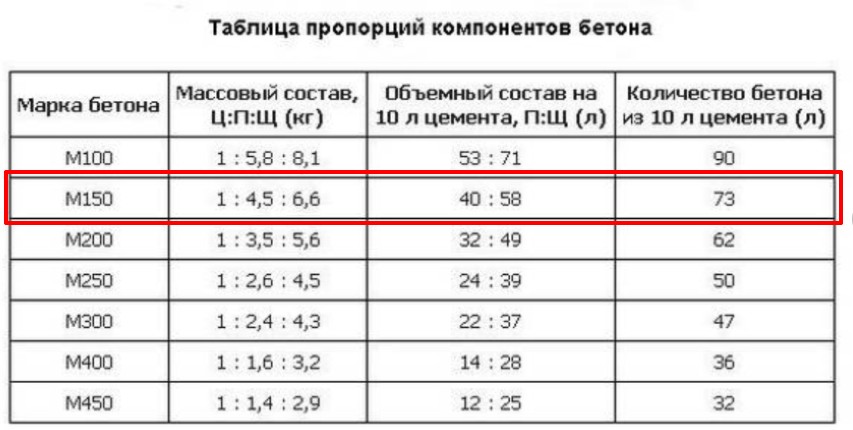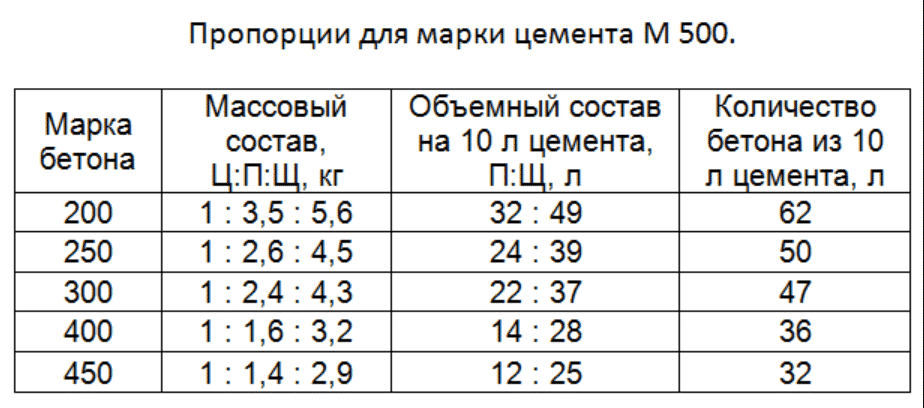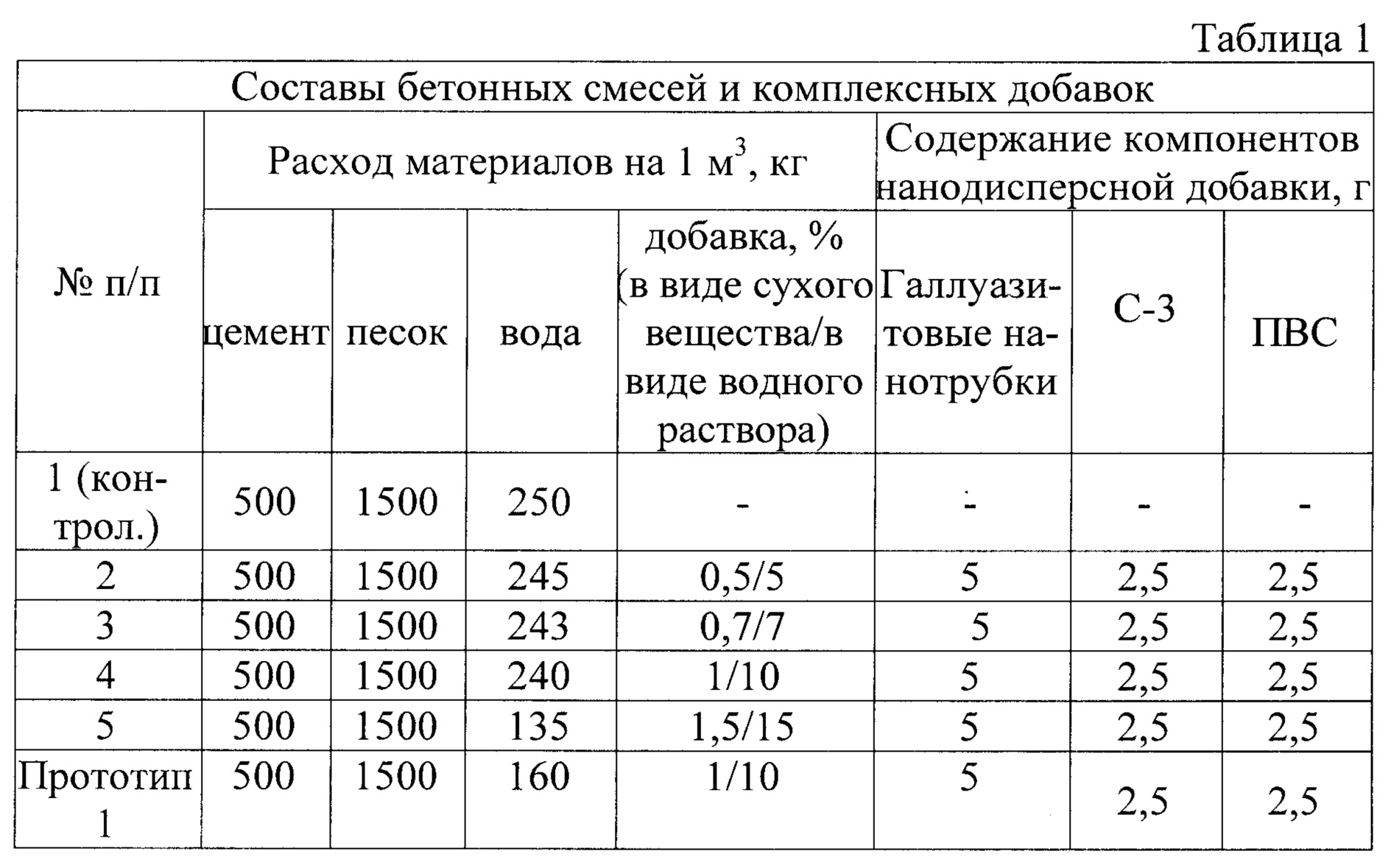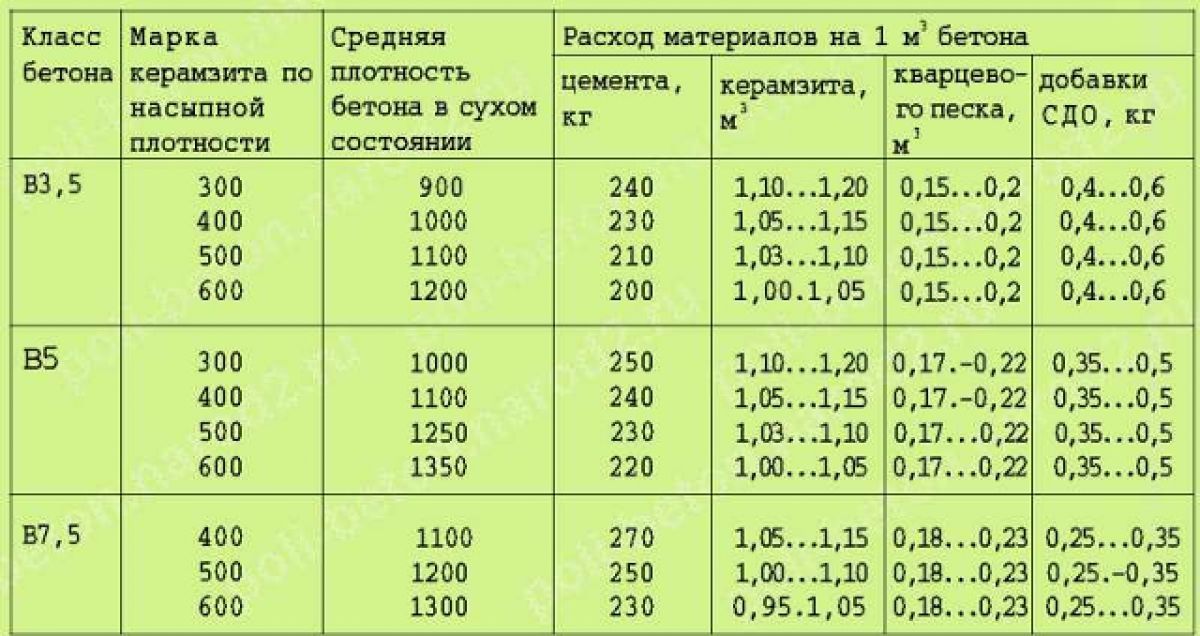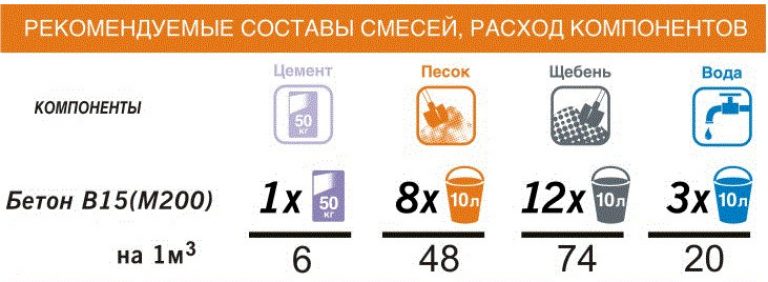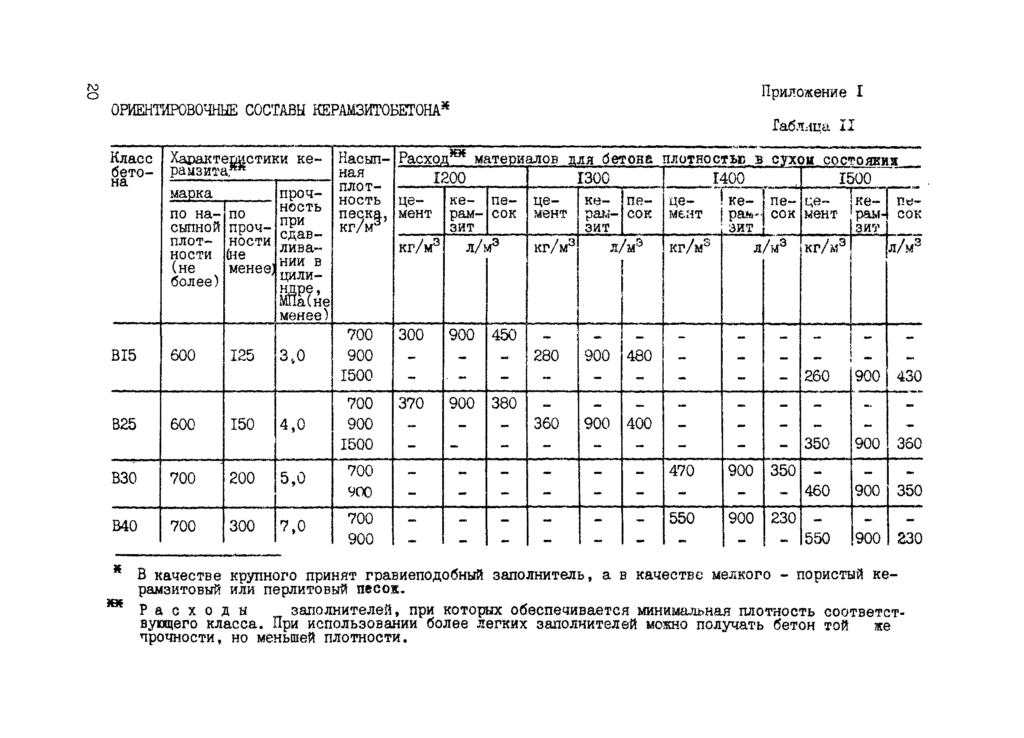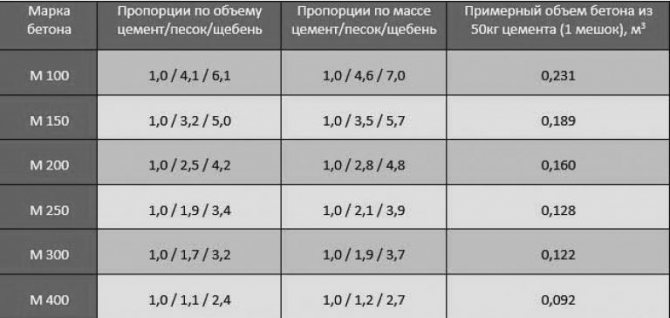The proportions of concrete of different brands
All this assortment and spectrum of qualities is obtained using the same materials, just in different quantities. To achieve the required characteristics, the recommended proportions must be strictly observed.
When building your home, you want to do everything as best as possible, and therefore, when composing concrete, there is a desire to add more cement: to make it stronger. This should not be done. It is unlikely to get better, but worse - easily. For the curing of concrete, a certain amount of water and other components is required. If there is little water, there is a lot of cement, bonds between particles are formed in an insufficient amount, because of which the concrete can crack and crumble. The same applies to the number of placeholders. And too much of their content, and insufficient, negatively affects the qualities of the concrete stone.
Concrete proportions are usually displayed in fractions. The amount of cement is taken as a unit, and the remaining components are prescribed in relation to it. The data are given in the form of tables for the respective brands, units of measurement are required. You can see such a table of concrete components below.
Proportions of concrete of different grades from Portland cement M400 and M500
How to determine the required proportions of concrete from this table? Find the grade of concrete you require in the second column. For example, you need an M250. Depending on which Portland cement you will use M 400 or M 500, choose one of two lines. The third column shows the proportions for concrete in kilograms: for 400 cement it is 1 / 2.1 / 3.9. This means this: to obtain concrete of the M 250 grade, for 1 kg of M400 Portland cement, 2.1 kg of sand and 3.9 kg of crushed stone must be added. In a similar way, you determine the proportions for concrete M200 - the data for it in the table are slightly higher, or concrete M 300 is slightly lower.
The fourth column shows the volume fractions: all components are given per 10 liters. They are selected in the same way.
These tables do not indicate the amount of water. It depends on how thick you need the solution. The water-cement ratio is given in separate tables. For example, below is the data on the number of inputs in relation to a kilogram of cement, assuming the use of medium-sized aggregates.
The amount of water for obtaining concrete of the required grade when using crushed stone and sand of medium size
For example, to obtain concrete grade M 300, the proportions of cement M 500 and water are defined as 0.61. This means that 0.61 liters of water (610 ml) is added to the solution for 1 kg of cement. This produces a medium-plastic solution, which is used most often. > However, when pouring foundations or other structures with thick reinforcement, a plastic mortar may be required. Then, when determining the amount of water, in addition to the brand of cement, it is also necessary to take into account the size of the aggregates and how fluid the solution should be. These data are presented in the table below.
The amount of water in concrete depending on the size of crushed stone / gravel and the fluidity of the solution
Sometimes it is necessary to determine how much cement you will need for a particular task. To do this, you need to know how much cement is contained in a cubic meter of concrete. You will find data on grades of concrete and cements in the table below.
The amount of cement per cube of concrete
How to make concrete 200 marks
To prepare a concrete mixture of a two-hundredth grade, you should:
- choose a recipe depending on the brand of Portland cement used;
- decide on the method of dosing components (weight or volume);
- prepare equipment and tools;
- take in the required quantities the components required for mixing.
Further procedure:
- Mix Portland cement thoroughly with sand.
- Add frost additive or other additives as needed.
- Mix the ingredients with water gradually.
- Add crushed stone, stir the mixture for 3-5 minutes.
Please note that the deviation from the recommended proportion should not exceed 1%
Composition and proportions
The composition of concrete M500 includes only highly refined materials that meet certain requirements. The following are used as placeholders:
- granite crushed stone of a single fraction from 30 to 50 mm, the same size is necessary so that the load is evenly distributed over the monolith, the granite from which the crushed stone is made is very durable;
- sand of only the first category, river or washed quarry, allows you to maintain strength and density;
- purified water should not include foreign inclusions, salts, organic impurities.
As a binder, cement grade 500 is used, which is responsible for the strength of the mixture and the high-quality adhesion of the fillers.
The ratio of the components of concrete mixtures is a key parameter in the manufacture. They are indicated in the mass ratio of cement, sand, granite crushed stone and water. For M500, this ratio is 1: 1.1: 2.3 and 5 parts of water, respectively.
This one is manufactured under industrial conditions, with strict quality control. It must withstand a high load on the supporting elements of the structure, therefore foreign inclusions that reduce the quality indicator are unacceptable in it. It is not used for the construction of piers and exterior walls of low-rise buildings, as it is unprofitable.
The cost of concrete M500 does not allow the use of the material when performing basic construction work. But the construction of special structures operating under high dynamic, static and vibration loads is not complete without the use of this unique building material.
Cooking proportions
For the preparation of concrete grade M400, a standard set of materials is used, which are mixed in the appropriate proportion. Cement M500 and M400 can be used in production. Depending on the brand of binder, the mass fractions of the components may vary slightly. The proportions for the production of 1 m³ of concrete solution are shown in the table:
| Cement grade | Proportions
C: P: U: V |
Cement, kg | Sand, kg | Crushed stone, kg | Water, l | Concrete cube weight, kg |
| M400 | 1:1,5:2,5:0,5 | 420 | 625 | 1085 | 190 | 2315 |
| M500 | 1:1,9:3:0,5 | 357 | 675 | 1085 | 190 | 2304 |
Knowing the exact ratio of the components, you can accurately calculate the amount of materials and production costs to produce the right amount of concrete. It is known that the cost of one cube of this building material is 3700-4300 rubles. This will make it possible to more accurately calculate the economic component of the project. To increase the mobility of the mixture, it is not recommended to use more water; for this, special plasticizers are used, which will require about 7.5 kg. To obtain full compliance with the declared quality, it is better to order this material at a concrete plant. At the same time, it is necessary to strictly adhere to the delivery and laying schedule of this material, since it quickly sets.
But in small or private production, volume fractions are used for the manufacture of concrete mixture. In this case, the standard bucket is most often used as a measure, the volume of which is 10 liters. To make one cubic meter concrete M400 will require the following number of components:
- Portland cement M400 - 32.3 buckets;
- Refined river or quartz sand - 41.7 buckets;
- Gravel or granite crushed stone - 80.4 buckets;
- Water without salts and organic impurities - 19 buckets.
Based on this proportion, you can find out the number of buckets for any volume of concrete. For example, to prepare 100 liters or 10 buckets of mortar, the number of buckets of cement, sand, gravel, water just needs to be divided by 10. You can mix the mortar using a concrete mixer or manually using a suitable container and a shovel. In both cases, it is necessary to achieve the most homogeneous mixture of thick sour cream consistency.
Often, portable concrete mixers are used to make concrete in private construction or in small industries. At the same time, cheaper cement M400 is purchased. A standard tank of such a mixer holds about 150 liters, but in order to avoid losses during manufacture, it is filled no more than two-thirds, which is 100 liters. To make such an amount of concrete M400 or B30, you will need to take:
- Cement M400 - 3.2 buckets;
- Sand - 4.2 buckets;
- Rubble - 8 buckets;
- A little less water - 2 buckets.
After thorough mixing, a plastic mixture is obtained, ready for use, in all respects corresponding to concrete M400. When making this material exact proportions are required so as not to degrade its performance. At the same time, you need to be aware that after complete curing for 28 days, the monolith will be resistant to processing; diamond discs and drills will have to be used to cut or drill it.
Features and Applications
Class B15 concrete is classified as structural concrete. The bearing frames of buildings (slabs, panels, columns) that do not perform heat-shielding functions are made from it. In terms of density, B15 is heavy. By the use of binders - concrete class B15 grade M200 are made on M400 or M500 Portland cement. The composition includes, in addition to cement, crushed stone, sand and water with certain properties and in proportions selected for.
For concrete stairs and pouring sites that experience temperature drops (negative and positive), use B15 concrete with frost resistance F75 or F150. Frost resistance F50 is determined by testing a sample for the ability of structures to maintain the design strength grade by 85% at 50 freeze-thaw cycles.
The foundation for the house can be made of different brands, both in terms of strength and frost resistance. The grade of the mixture for the internal bearing walls of the foundation of a heated building may not be standardized for frost resistance. This is due to the fact that the mixture of class B15 already has frost resistance. And the additional requirement for the number of cycles applies to structures that can receive 50 or 75 cycles during the entire service life.
A number of special requirements may be imposed on designs. For example, in hydraulic structures, the waterproofing mark should be at least w4. In the construction of blast furnaces, heat-resistant concrete based on Portland cement with special additives (chromite and magnesite) is used. This composition of the mixture is not destroyed at temperatures up to 1700 ° C.
The fulfillment of the concreting requirements consists of several stages:
- On concrete nodes, the future composition of the B15 brand is selected in percent.
- Prototypes are tested in laboratories for compliance with the brand strength, the data are entered in the passport.
- At the construction site, the contractor is obliged to fill in test control cubes measuring 150 x 150 x150 mm from each batch. Samples should have the same curing conditions as the main structures.
- On the 28th day, the construction organization tests control samples, the results are recorded in the work production log. The as-built documentation is presented to the customer to the Act of putting the facility into operation.
- The cube strength of the samples must be converted to the brand strength in accordance with the conversion table.
DIY tips and tricks
Many land owners often undertake to produce concrete with their own hands. For small volumes and with lax requirements for strength characteristics, such a measure is fully justified.
Tools
To make concrete mix M300 with your own hands, you will need a concrete mixer and hand tools.
Concrete mixer - the type of this mechanism and the volume of its drum depends on the required amount of concrete mix. For the manufacture of pedestrian paths, filling small areas in the yard, a concrete mixer with a drum volume of 60-80 liters will suffice.
When arranging the foundation of a garage, bathhouse, utility rooms, the one-time productivity of a concrete mixer should be already 100-120 liters, and in order to prepare the required amount of concrete for the construction of a buried or slab foundation of a residential building, a base for a stone fence, a more solid machine is needed - 150-250 liters.
The hand tool is a shovel for loading bulk components, buckets for pouring water into the mixer, measuring containers for precisely observing the proportions of the composition.
Production procedure
Production should be carried out in the following order.
Pour into the mixer about ¾ of all the water required according to the calculations. Turn on the rotation of the drum or blades (depending on the type of concrete mixer). Add the required amount of cement to the working volume. As a result of mixing water and cement, you get a cement laitance, which has the best adhesive properties. The next addition to the composition is crushed stone, and lastly, sand.
There is no fundamental difference in the order of adding ingredients, but the experience of builders shows that it is this order that reduces mixing time and improves the uniformity of the mixture. Stirring should take at least 5 minutes. The achievement of the desired quality and the end of the procedure can be judged by the fact that it is impossible to determine the initial color of the particles of crushed stone and sand in the mixture - they all acquired the color of a cement mortar.
When using the manufactured concrete, it must be remembered that from the moment of contact between water and cement, the process of formation of solid bonds began, that is, the mixture began to solidify, therefore it is necessary to work quickly and continuously. The hardening time of concrete decreases with an increase in the ambient temperature and the components of the mixture.
Concrete mix components
Concrete is the name given to a hardening concrete solution. It is represented by a mixture with good plasticity, including a binder component, grout and aggregates of different fractionation. In some cases, to impart the required properties, various plasticizers, stabilizers, and water repellents are added to it. The best option as a binder is Portland cement (cement M400, M500), mixed with water.
Fine aggregate is sand with a grain size of 0.14-3.5 mm. And gravel with crushed stone acts as a large one. All components are mixed in the required proportions and the mixture can already be used.
Concrete mix components.
If it is necessary to increase the strength characteristics of concrete, it is reinforced with a steel frame (steel mesh).
Before falling asleep in the prepared sand mixture, it is cleaned by sieving and removing large foreign inclusions.
Gravel as a coarse aggregate should have a particle size of about 50 mm, maximum 70 mm. The admixture of foreign particles should be no more than 1: 100 of the total volume of the material.
When planning the use of crushed stone, it is checked that in the majority of its mass it has a rounded shape. Flat stones are unsuitable for these purposes. For gravel, the size of the fractions must also meet the requirements for this material.
The solution is prepared on the basis of tap water with low acidity and a slight inclusion of sulfates with salts.
Synthetic additives (in addition to those mentioned above, also corrosion inhibitors) make it possible to improve the quality of the mixture for use.


